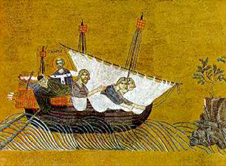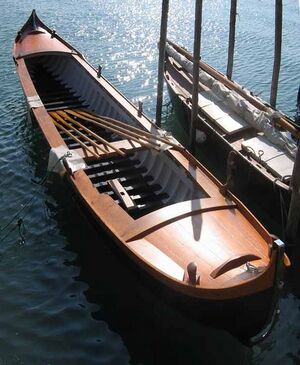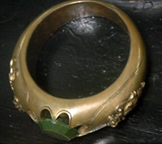Maritime heritage
Venice is a city of land and water. The land is so closely tied to the water that in the city’s early years there were no fondamenta, or foot-paths. Today, these foot-paths enable people to walk around the city. Instead, the land met the water via a gentle slope so that the Venetians could move from land to sea effortlessly. Venetians rowed in a standing position because that was the position of a walking man. These boats and styles of rowing have given Venice a unique quality that no other place in the world has. Traditional Venetian watercrafts “are the true heart of the city because they represent the meeting of land and sea, that symbiosis which is Venice and which makes it unique in the world.”
Boats in Venice
The traditional boats of Venice filled the canals for centuries, until a drastic decline starting in the 1970s. With the exception of the gondola, there are no traditional boats currently being produced in Venice for work purposes. However, what people do not realize is that the gondola is only one style among about 40 documented that fall into the category of traditional boats. Each one is hand-crafted with a unique design to carry out a specific task.

The fascinating world of traditional boats has shaped the Venetian culture and lifestyle for centuries, but many have no idea what constitutes a traditional Venetian boat. This lack of knowledge is not simple “tourist ignorance,” but is rather due to the fact that traditional boats are very rare today. Motor boats dominate the canals which, for the bigger part of Venice’s history, were traversed by rowed traditional boats. Once popular, there are no longer any row boat facilities, fitabatele, in Venice that still rent traditional boats to the public. One organization in Venice that is dedicated to keeping the heritage of the traditional Venetian boat alive is Arzana. Arzanà consists of volunteer mariners who work to keep and restore traditional boats, as well as the nautical heritage that are associated with them. Arzanà works with boats that have been abandoned or donated in an effort to keep these precious artifacts from disappearing all together. Venetian culture is intimately connected to traditional boats, whose very existence is threatened and whose legacy is doomed to be lost forever if there is no immediate action taken.
Replacing rowed boats with motor boats seems like simple evolution; it is the natural step in the progress of the culture. Asking Venetians to return to total dependence on traditional boats would be akin to the return of the horse and carriage in any other city: a completely impractical solution. The traditional boats of Venice should be preserved as cultural treasures, however, in order to keep the nautical heritage, which has so visibly shaped the city, alive. The cultural and physical union with the sea is one that is rooted in the history and geography of Venice.
Influence of Geography

The city of Venice is built on 125 different islands, which are connected by over 182 canals and 473 different bridges. However, that level of structure didn’t always exist – early in the city’s history, the individual islands were isolated in their development; the only contact between islands was wooden planks and boats. Early Venetians recognized the link that they had with boats – they built homes not just for themselves, but also open-bottomed, three-sided structures which could house their boats. The land is so closely tied to the water that in olden days there were no fondamenta, or foot-paths, like there are today that enable people to walk around the city. Instead, the land met the water via a gentle slope so that the Venetians could move from land to sea effortlessly. Venetians rowed in a standing position because that was the position of a walking man. They always looked straight ahead as if they were men who never under orders. This style of rowing allowed rowers to greet one another and speak to each other on the water, just as they would on land. These boats and styles of rowing have given Venice a unique quality that no other place in the world has. By the sixth century, their reputation was as formidable seamen. Venetians were famed for their maritime skills, including the innate ability to sail boats against the current and to navigate the treacherous lagoon.
Venice was considered to be a maritime republic since the 5th century and a dominant naval power since the 10th century when it began gaining control of the Adriatic. As Venice gained power from its naval force, it gained privileges in the eastern Mediterranean ports and began to capitalize on the advantages it had over other medieval trading city-states at the time. The city’s location, government policies, and skills gave Venice distinct advantages over other city states, thereby making Venice the prime trading center between the eastern Mediterranean ports and Europe in the 12th century. , By the 15th century, Venice was known as the “queen of the seas” because it was the main trade link between Europe and Asia. The city’s strength was felt all around the world because of its ambassadors who were the creators of modern diplomatic service. Its arsenal, the Arsenale, which was founded in 1104 and rebuilt in the 15th and 16th century, was one of the world’s wonders at the time.
At its peak in the 15th century, the Arsenale employed 16,000 men and could produce a galley, a Venetian warship, during a lunch break. The senate of the Venetian government, the Signoria, was able to successfully focus on trade in the 16th century as state-of-the-art watercrafts were built quickly and constantly improved. Watercraft during this time period was a vital part of Venetian life.
Nautical Heritage Elements in Venice

Many Venetian customs and traditions developed around the dependence on the sea. According to tradition, the Doge, the ruling entity of Venice, was “married” to the sea. Each year, in a celebration called the Festa della Sensa, the Doge would cast a large ring into the sea. Similar to other cultures, Venice was prolific in its creation of art and architecture, and pieces typically were focused around different aspects of the city’s maritime heritage. One of the most popular tourist sites in Venice, St. Mark’s Basilica, contains many pieces of artwork depicting different boats and the sea. One example is the Translation of St. Mark, a mosaic from the 13th century that can be seen on the west-wing vault in the San Clemente Chapel in St. Mark’s. Similar mosaics can be found on the three other walls of the chapel, and illustrate not just Venice’s link with the sea, but the connection between the sea and religion. However, artwork relating to the sea is not just seen in churches – many pieces of public art seen throughout the city have a nautical theme. These are several examples of the different nautical heritage elements which can be seen throughout the city of Venice. In 2005, a study was conducted by students from the Worcester Polytechnic Institute to identify elements of Venice's nautical heritage. In the study, 33 places of nautical interest were identified including, but not limited to, ten churches, one monument, three museums, and 14 squeri. Some can be seen simply by visiting popular tourist sites, including San Marco, the Palazzo Ducale, and the Museo Correr. The nautical heritage of Venice is seen not only in building and artwork, but also in street names found throughout the city.

The streets were often named after the different vendor’s shops located there, and though many of those shops have closed the names remain. The Worcester Polytechnic Institute, in a similar study, catalogued 26 street names containing the word Barche (boats), four containing the word Felzi, nine containing Remer (oar-maker), 17 containing Squeri or Squero, and 19 containing Traghetto (gondola taxi), with a total of 75 streets referring to some kind of nautical aspect.
See Also
References
NULL
Bibliography
- The Boats of Venice. Venezia: Libreria Editrice, 1999. Print.
- Bigda, Bryan, Michelle Dubuke, Daniel LaTorella, and Jennifer Richards. Museo Arzanà: Preserving the Traditional Boats of Venice. Interactive Qualifying Project, Worcester Polytechnic Institute, 2007.
- Candlish, Sean, Craig Shevlin, and Sarah Stout. The Traditional Boats of Venice: Assessing a Maritime Heritage. Interactive Qualifying Project, Worcester Polytechnic Institute, 2004.
- Catalano, Brian, Kristen Gervais, and Ryan Sinapius. Preserving the Nautical Traditions and Maritime Heritage of Venice, Italy. Interactive Qualifying Project, Worcester Polytechnic Institute, 2005.